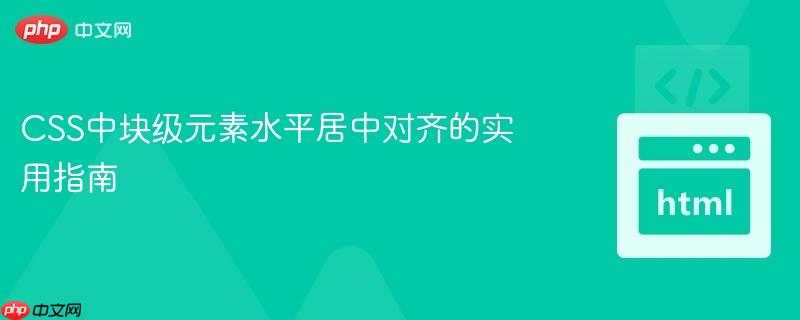
在网页设计中,尤其是在构建响应式布局时,将元素水平居中是一个非常常见的需求。默认情况下,块级元素(如div、p等)会占据其父容器的整个可用宽度,并从左侧开始排列。当我们需要一个宽度小于100%的块级元素在其父容器中居中显示时,就需要应用特定的css规则。对于初学者来说,这可能是一个令人困惑的问题,因为简单的text-align: center属性通常只对行内内容(如文本、图片)有效,而不能直接使块级元素本身居中。
实现块级元素水平居中的最经典和最可靠的方法之一是使用margin: auto。这个方法的核心原理是,当一个块级元素拥有明确的宽度(width属性被设置)时,如果其左右外边距(margin-left和margin-right)都被设置为auto,浏览器会计算剩余的水平空间,并将其平均分配给这两个外边距,从而将元素精确地放置在父容器的中心。
考虑以下HTML结构,其中包含一个名为think的div元素,我们希望它在其父容器中水平居中:
<div class="rapper">
<div class="commun">
<div class="think">
<p>eipuriepauip uipeojiupeiurqiewp uipeuiepuirepw uirepqrueiqp ufiepfipeiwp euipuqieupriqewp</p>
<div class="xitf">
<a class="xit" href="https://www.freecodecamp.org/">
<button type="button">SIGN UP</button>
</a>
</div>
</div>
</div>
</div>最初的CSS可能如下所示,其中think元素被赋予了90%的宽度,但缺乏居中指令:
.think {
width: 90%;
text-align: center; /* 居中其内部文本内容,而非元素本身 */
padding: 5px;
background-color: black;
color: #F2F2F2;
margin-top: 20px;
}在这种情况下,.think元素会因为其width: 90%而占据90%的宽度,但会默认靠左显示。text-align: center只会影响其内部的文本和行内元素,而不会使.think这个块级元素本身居中。
立即学习“前端免费学习笔记(深入)”;
为了使.think元素水平居中,我们只需要对其CSS规则进行简单的修改,添加margin-left: auto;和margin-right: auto;,或者简写为margin: 20px auto 0 auto;(这里的20px是margin-top的值,0是margin-bottom的值,auto是左右外边距的值):
.think {
width: 90%;
text-align: center;
padding: 5px;
background-color: black;
color: #F2F2F2;
margin-top: 20px;
margin-left: auto; /* 新增 */
margin-right: auto; /* 新增 */
}或者使用更简洁的margin属性简写:
.think {
width: 90%;
text-align: center;
padding: 5px;
background-color: black;
color: #F2F2F2;
margin: 20px auto 0; /* 上外边距20px,左右外边距auto,下外边距0 */
}应用此更改后,.think元素将完美地在其父容器中水平居中。
下面是修改后的完整CSS和HTML代码,展示了如何将.think元素水平居中:
HTML:
<div class="holdon">
<a href="www.hotmail.com" class="boom">
<img src="IMAGES/GOOOOOOOO.png" alt="dummy" height="100px" width="100px">
</a>
</div>
<div class="rapper">
<div class="commun">
<div class="think">
<p>eipuriepauip uipeojiupeiurqiewp uipeuiepuirepw uirepqrueiqp ufiepfipeiwp euipuqieupriqewp</p>
<div class="xitf">
<a class="xit" href="https://www.freecodecamp.org/">
<button type="button">SIGN UP</button>
</a>
</div>
</div>
</div>
</div>CSS:
.boom {
position: relative;
padding-left: 5px;
bottom: 112px;
}
.think p {
display: inline;
}
.think {
width: 90%;
text-align: center;
padding: 5px;
background-color: black;
color: #F2F2F2;
margin-top: 20px;
margin-left: auto; /* 关键的居中属性 */
margin-right: auto; /* 关键的居中属性 */
}
.xit button {
color: white;
padding: 5px 70px;
background-color: forestgreen;
border-radius: 12px;
font-family: istok-web;
}
.xit button:hover {
background-color: white;
color: green;
}掌握margin: auto是CSS布局中的一项基本技能,它能高效且可靠地实现块级元素的水平居中对齐。通过为具有固定宽度的块级元素设置margin-left: auto; margin-right: auto;,可以确保元素在父容器中完美居中,这对于构建美观且响应式的网页界面至关重要。虽然现代CSS提供了Flexbox和Grid等更高级的布局工具,但margin: auto在许多场景下依然是简洁有效的解决方案。
以上就是CSS中块级元素水平居中对齐的实用指南的详细内容,更多请关注php中文网其它相关文章!

每个人都需要一台速度更快、更稳定的 PC。随着时间的推移,垃圾文件、旧注册表数据和不必要的后台进程会占用资源并降低性能。幸运的是,许多工具可以让 Windows 保持平稳运行。

Copyright 2014-2025 https://www.php.cn/ All Rights Reserved | php.cn | 湘ICP备2023035733号